Tag: Creating wildlife champions
Sadly, UK wildlife is in decline.
In fact, nature is doing a lot worse in the UK than in most other countries around the world.
According to the State of Nature report, released by RSPB and 50 other wildlife organisations, over 56% of our incredible species have declined over recent decades and 15% of UK species are threatened with extinction. There are a range of factors that are driving this decline, including agriculture and climate change.
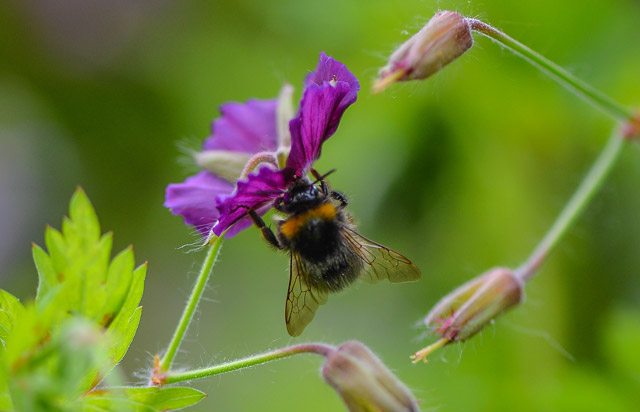
Everything we do in our day-to-day lives can have an impact on nature – from the food we eat to the energy we use – everyone has a role to play in conservation and it’s more important than ever that everyone does their bit.
We ALL need to get involved if we’re going to make a real difference.
One simple thing to do is record the wildlife we see; it’s such an important action that we can all contribute to and the data collected enables conservationists to keep an eye on any changes or trends and take action before it’s too late. The more information we have about our habitats, the more we can do to help protect them.
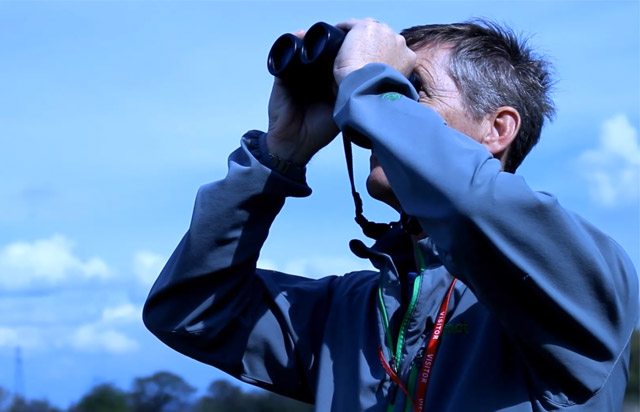
There are also plenty of other benefits to wildlife watching too – it’s relaxing, you can learn more and it gets you outdoors! Fancy giving it a go? Here are some hints and tips on watching and recording wildlife.
Creating safe habitats for our local wildlife has been highlighted as one of the most beneficial conservation actions for wildlife. Habitat creation is not just about nature reserves, it includes our homes, gardens and local green spaces too. And by creating safe spaces for wildlife we’re creating a better landscape for nature.
Wildlife Connections is about helping reverse these declining trends by helping to open up our landscape to wildlife with wildlife corridors and making new areas of good habitat in gardens and community spaces that will help the wildlife around us thrive.
The pine marten recovery project we’re working on with The Vincent Wildlife Trust was just one example highlighted in the State of Nature report of how conservation action is helping to reverse the decline in UK species. And we’re also really proud to be working together with a number of other partners across the UK to help save other species, like the hazel dormouse, Scottish wildcat and the black poplar.
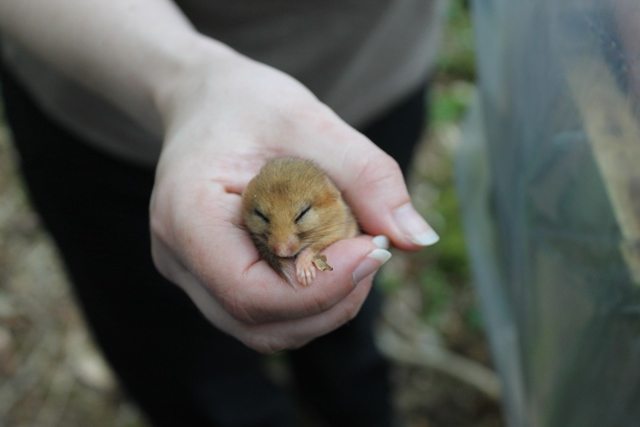
On top of the work we’re doing in the field, our staff at Chester Zoo are using their skills and expertise to increase animals and plant populations through conservation breeding and plant propagation, for reintroduction into the wild.
The state of UK nature is bad – but we will continue to act for our precious wildlife! We’re so lucky to have such amazing wildlife right here on our doorstep and we need your help, not only to make Wildlife Connections, but to also spread the word! The more people that take action, the more wildlife we’ll be able to protect.
We’re in this together and we can all make a difference to help save our wonderful local wildlife.
The recent trip was a great opportunity to talk about current conservation challenges, progress made so far and to look forward at future opportunities where we can help make a difference.
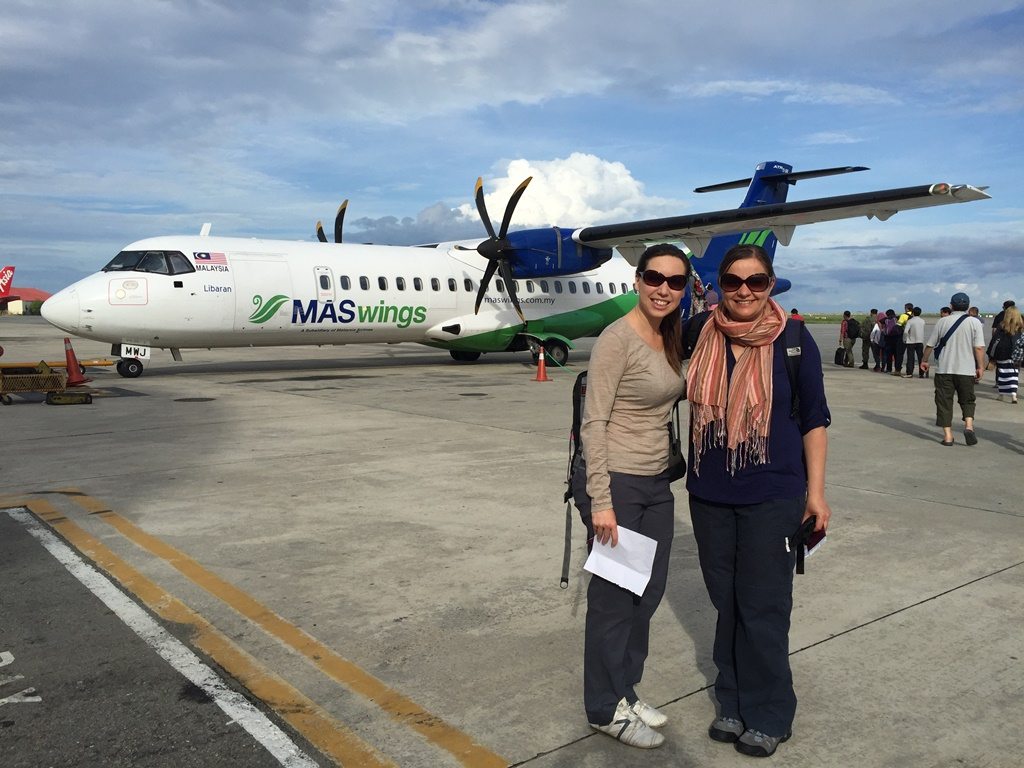
Jenny tells us more about the field trip:
Meeting the orangutan research team…
“The data gathered from monitoring the orangutans in the field is crucial for estimating population sizes and understanding more about their ecology. In recent years, orangutans have had to adapt to their ever-changing environment, as oil palm plantations and other human activities encroach upon the rainforest they depend upon. Understanding how orangutans adapt to these changes and their fundamental needs is vital information if we are to conserve and protect them.
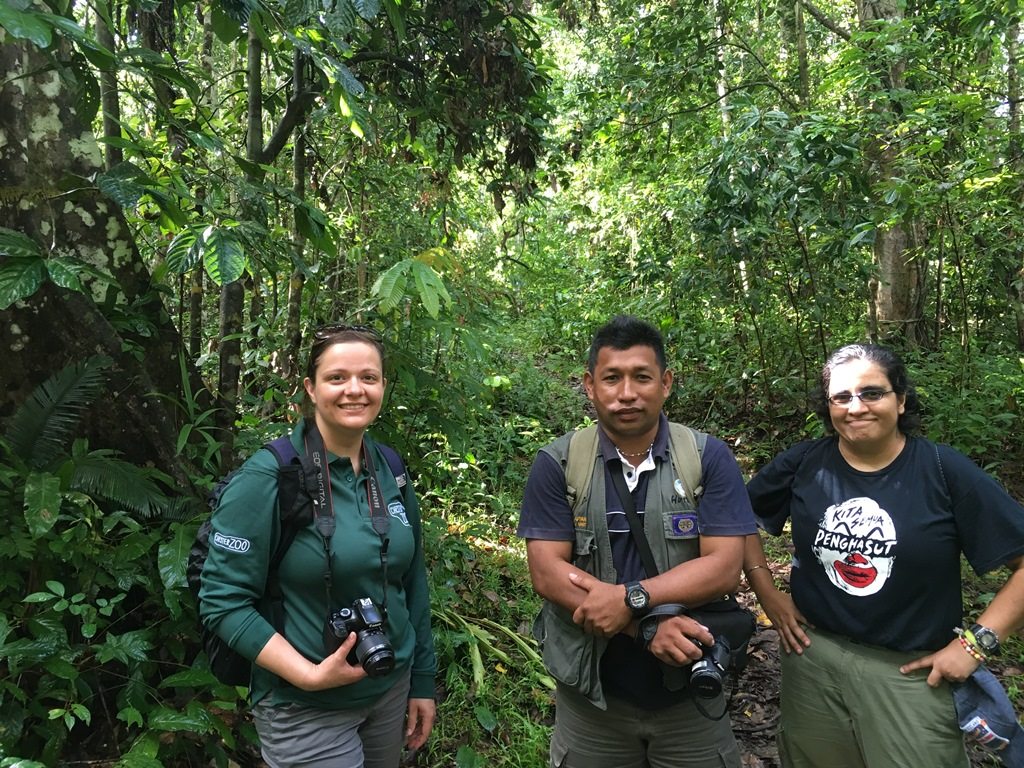
Jenny (left) with some of the HUTAN team. Photo credit: HUTAN
It was a real privilege to observe orangutans in the wild and to meet the HUTAN team dedicated to monitoring them.
“Most recently, HUTAN’s research has also resulted in the Bornean orangutan being officially classified as ‘critically endangered’ on the IUCN Red List – only one step away from ‘extinct in the wild’. We need to work together to make changes in the management of habitat to ensure that humans and orangutans can successfully co-exist.
Meeting the HUTAN warden team…
“The wardens carry out enforcement activities around the Kinabatangan, monitoring human activity in and around the forest and providing a crucial link between the conservationists and the local community.
“Wildlife surveys along the river are a large part of the wardens’ responsibilities: this includes monitoring the eight species of hornbill found in the region and their use of the artificial nest boxes we assisted the team to create in 2013.
“Azri, head of the warden team, took us to see the orangutan bridges and nest boxes that our team helped HUTAN to create. It was rewarding to also visit a reforestation site which our team visited and helped to plant five years ago. The site had been illegally planted with oil palm trees, but was reclaimed and replanted with fast growing native species. The site was monitored for three years after planting and is now well established.
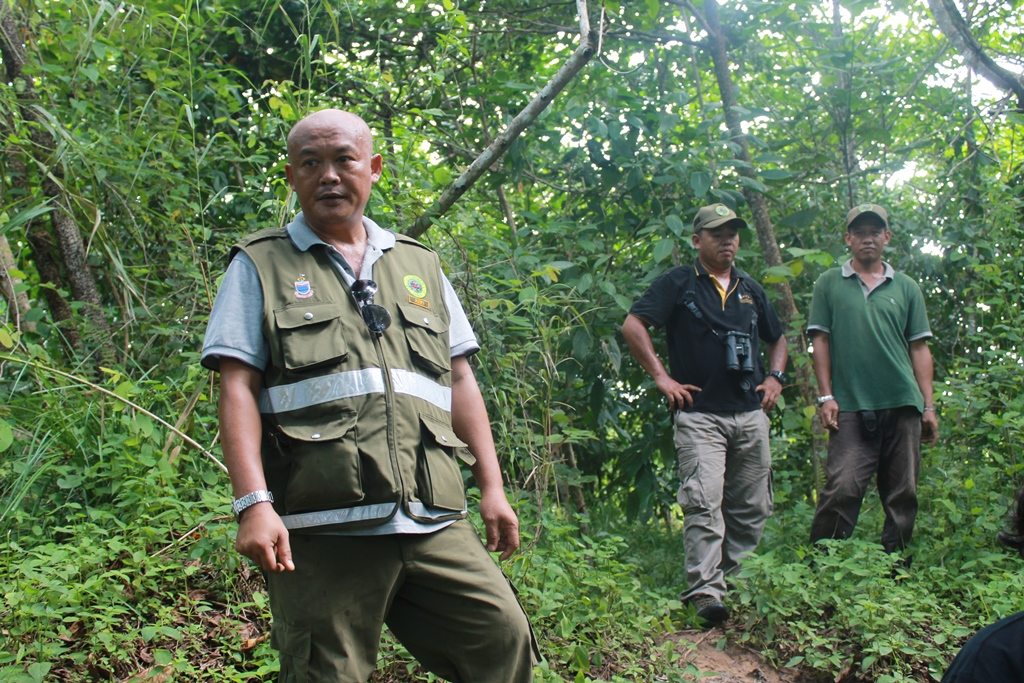
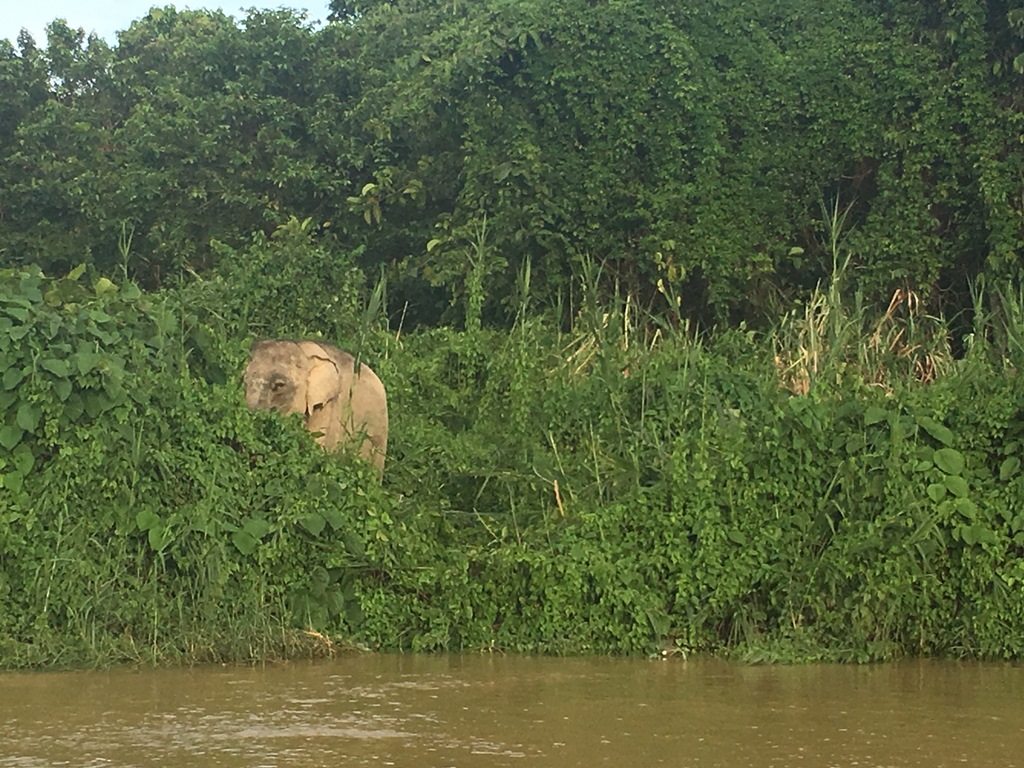
“These wild elephants walked along the river and then disappeared off into the oil palm plantation behind – a reminder that these forests are home to so many animal species and made us more determined to work to protect them.
Visiting a sustainable palm oil plantation
“As part of our Sustainable Palm Oil Challenge we have been encouraging people to buy products that have been certified by the Roundtable on Sustainable Palm Oil (RSPO) as using certified sustainable palm oil.
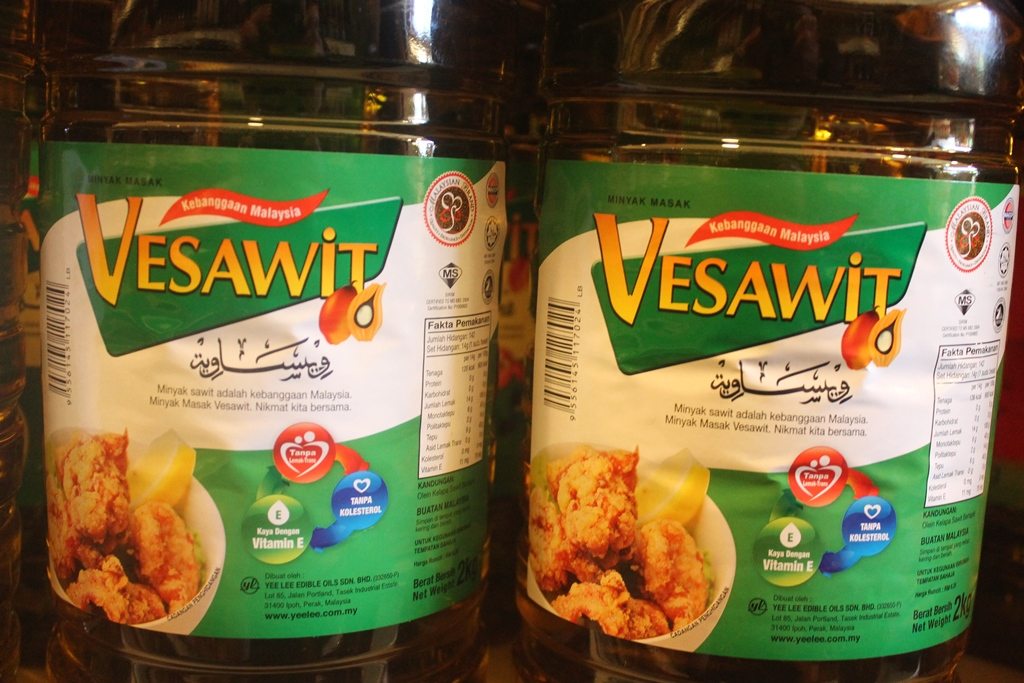
Two bottles of palm oil in a local shop.
“To gain a better understanding of what growing RSPO certified sustainable palm oil actually means, we were able to visit a certified plantation. It was encouraging to see the steps companies are taking to protect wildlife and achieve better working practices for their employees.
Working with the community
“For a number of years we’ve been working with HUTAN’s education team (HEAP), assisting with a strategy for their learning programme. Their programme centres on improving knowledge about the forests and the negative impact humans can have on wildlife.
“One of the focuses for this trip was to discuss next steps with the team and look into how some of the community and education skills we use can help the local community to get more involved in efforts to protect wildlife. We’ll be working with the HEAP team to assist their efforts over the months to come.
HUTAN is about people. We have a lot of hope for the future. Working with the community here, we can fix this
What’s next for our work in Borneo
“The recent news about the change in status of the Bornean orangutan has made the work we do in this region even more important. Ensuring that orangutans continue to exist in these human-dominated landscapes is a challenge which we’ll continue to help find solutions for through our partnership with HUTAN and our support of their work in the field. Our support for transforming the palm oil market to a sustainable supply is now even more critical.”
These forests are home to some of the most threatened species on the planet – including the iconic Bornean orangutan and pygmy elephants. As a zoo, we are in a unique position to provide technical support and assistance to projects on the ground, using our skills to help boost their conservation efforts. Conservation is all about partnerships and our relationship with HUTAN is exactly that; HUTAN have a strong sense that collaboration is key to successful projects.
Our partnership has grown over the years and despite the challenges that remain in the field, we continue to work hard to help make a positive difference.
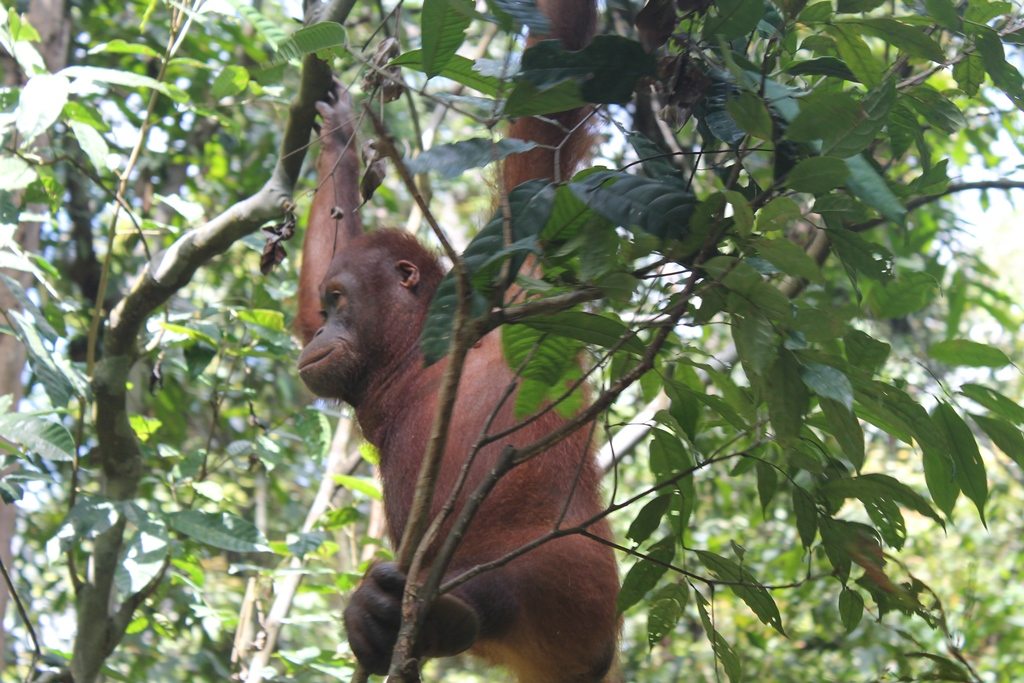
Working with the community to bring about change
For a number of years we’ve been working with HUTAN’s education team (HEAP), assisting with a strategy for their learning programme. Our Discovery and Learning team here at the zoo are specialists in their field and together with HEAP successfully produced a plan for their education programmes which centres on improving knowledge about the forests and the negative impact humans can have on wildlife. Over the years, the HEAP team have built up a positive reputation in the community and work closely with schools, other conservation organisations, government departments and communities to protect the wildlife of the region. Our next steps will look into how some of the community and education skills we use at the zoo can help the local community to get more involved in efforts to protect wildlife.
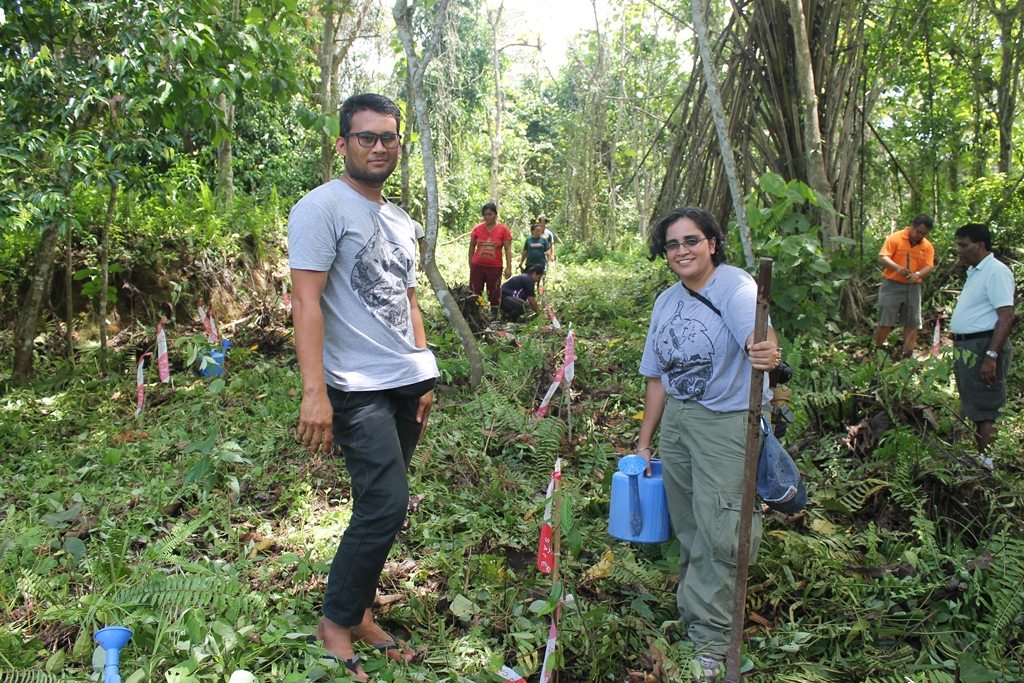
Sustainable palm oil
One of our key campaigns at the zoo is our Sustainable Palm Oil Challenge, aiming to increase the demand for sustainable palm oil. This is a hugely important campaign for us, as it directly impacts the work that our partners are doing in the field. By working on the consumer end of the palm oil supply chain, we are backing up the work that HUTAN is doing in the field on the production end of the chain.
We are in a unique position as a conservation organisation to help promote behaviour change; not only are we a conservation organisation that has over 1.6 million visitors a year to talk to, we are also a conservation organisation that procures and sells food items on site. This means that we can have a huge impact on the demand for sustainable palm oil in the UK. We work really hard with other UK and international partners to improve the sustainability of palm oil and increase demand, supporting HUTAN’s work on the ground. But we need your help too!
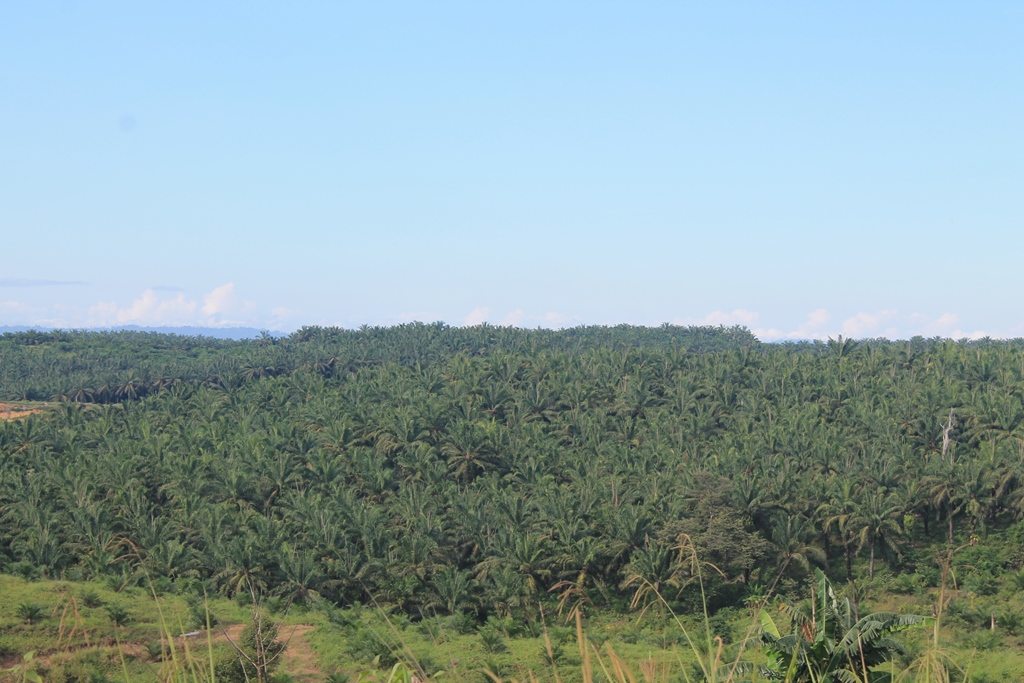
Orangutan bridges
Starting in 2004, the orangutan bridge project is an area we have increased our involvement in. The bridges are an innovative idea for reconnecting orangutan populations which have become isolated from each other for many reasons, such as oil palm plantations, roads and drainage channels. Following the initial six bridges built by HUTAN and partners, we got involved in 2011. The reason for our initial involvement was simple; HUTAN needed a new material to build their rope bridges with as the ropes they had been using were too heavy and could cause damage to trees. We discussed the use of webbing material used in our orangutan enclosure in the zoo which has unique properties; lightweight, non-biodegradable and UV resistant – perfect for the environmental conditions found in Sabah. Most importantly, the material had been tried and tested by the orangutans at Chester Zoo! Our teams at the zoo have been involved in two trips so far to build more bridges to connect vital patches of habitat and more are planned in the future. We also have great evidence now of the use of these bridges thanks to one observant tourist!
Artificial hornbill nest boxes
Eight species of hornbill are found in the Kinabatangan region; many are classified as endangered and the helmeted hornbill has been reclassified recently as critically endangered. Due to the forest being a secondary forest, it lacks old mature trees for hornbills to nest in. As a temporary measure, artificial nest boxes are a key part of the strategy to ensure the hornbill species remain and successfully breed in the area. For many years, our bird team in the zoo have been creating artificial habitat for hornbills to encourage conservation breeding. Our teams therefore have excellent knowledge and experience of trialling and testing these boxes to end up with a positive result for hornbill breeding. In 2013, we started to work with HUTAN on this new project to help develop a successful prototype to use in the field. The boxes built in 2013 are being monitored in the field by HUTAN, and we’re working in the zoo to develop new prototypes which will hopefully promote breeding by the larger more threatened hornbill species of the region.
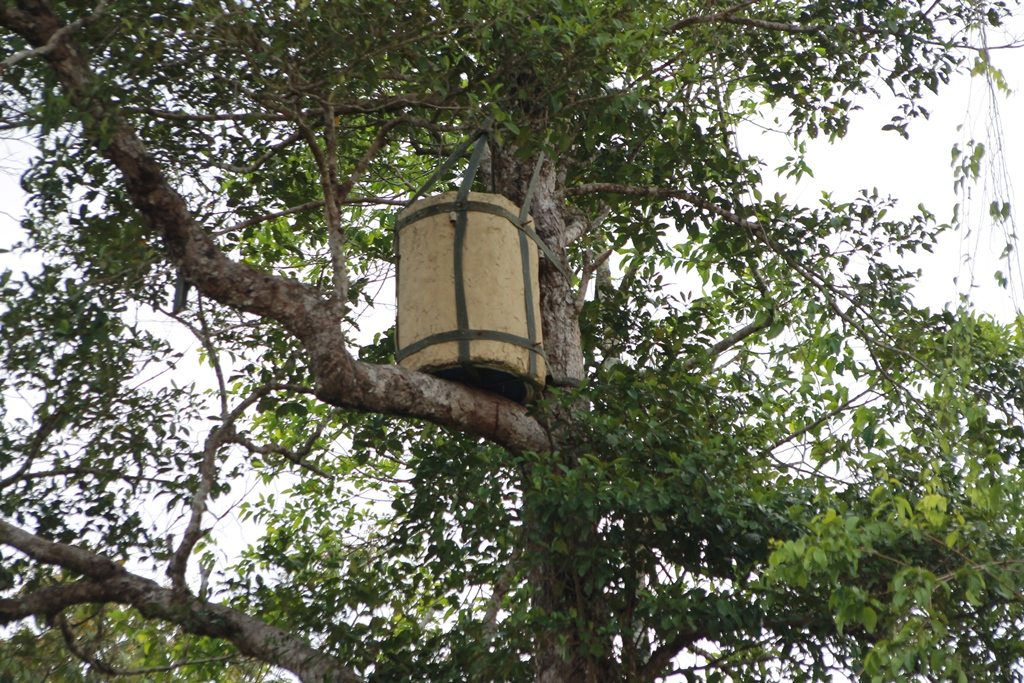 Artificial hornbill nest in a tree. Photo credit: HUTAN
Artificial hornbill nest in a tree. Photo credit: HUTAN
Social marketing
Our newest partnership project with HUTAN has recently developed with our marketing team at the zoo. Our marketing professionals have extensive experience in areas including website design, social media and behaviour change. All of these areas of work are important in communicating and promoting environmental protection. We’ve started to work alongside HUTAN to develop this area of work and we’ll keep you posted with how it goes!
We’ve shared many field updates with you from Patricia Medici (project coordinator) and her team, keeping you updated on the important work being done to protect tapirs in the wild.
Back in September Patricia visited Chester Zoo, where she spent time with our conservation team; but it also provided us with a great opportunity to catch up with her:
Last year was a big year for Patricia and the tapir project as she also presented at the Ted Fellows Retreat. This is a BIG deal! And it’s great coverage for tapir conservation worldwide.
Watch Patricia Medici’s talk below:
TED is a global community made up of people from every discipline and culture, devoted to spreading ideas. These ideas are usually presented in the form of short, powerful talks and aim to change attitudes and lives.
At the end of October we ventured into the world of theatre to raise awareness of the growing palm oil industry and how it’s affecting wildlife around the world. This piece of experimental theatre is part of our wider Palm Oil Challenge and aims to inform and inspire – showing people the impact palm oil is having on the environment and what we can do about it as consumers.
-small.jpg) The Plantation Game. Photo credit: Museum of Science and industry, Sebastian Matthes-Mannox
The Plantation Game. Photo credit: Museum of Science and industry, Sebastian Matthes-Mannox
The interactive game was created by award-winning makers of theatre, Coney, and was performed at The Lowry as part of the Manchester Science Festival and then at the zoo. Each table represented an oil palm plantation – they had to generate enough income to keep their workers happy, keep an eye on what their competitors were up to (the other tables) and decide which route to take when dealt a new business opportunity. It was great to see the different choices made by the audience and the consequences they faced as a result!
-small.jpg) Photo credit: Museum of Science and industry, Sebastian Matthes-Mannox
Photo credit: Museum of Science and industry, Sebastian Matthes-Mannox
Owen Chamberlain, from the University of Chester’s RECAP (Research into Education, Creativity and Arts through Practice) centre took part in the event here at the zoo and he kindly took the time to share his feedback of the adventure game.
“It was with some intrigue that I found myself at Chester Zoo on a Saturday night to take part in what had been described to me as a murder mystery, with the main suspect being a plant. Palm oil, as I was soon to find out, is not only in everything (including toothpaste apparently), but is also increasingly being grown everywhere. Not coming from an environmental standpoint, but having a minor eco-conscience (recycling is about my limit), I was interested to know more about what has been termed ‘Green Gold’.
“The night was based around a three course meal and in between each course came a new round to the game. Each table was assigned a country, given a selection of forest cards, and the task of making as much money as possible over the night, whilst simultaneously trying to not cut down everything.
-small.jpg) Photo credit: Museum of Science and industry, Sebastian Matthes-Mannox
Photo credit: Museum of Science and industry, Sebastian Matthes-Mannox
“Games like this usually bring out the worst in me, and it soon became obvious that everyone on my table was the same – we opted to cut down, bribe, use chemicals etc. We soon ended up with $20,000 (10K more than everyone else), however the clincher came at the end. I don’t want to give away too much, but we lost the game!
“And that is one of the major things to have come out of the evening for me. We are constantly told within media circles that the environment is in a losing battle with us – within our game, this was brought into a stark light. We had all the money, yet no forest, animals or soul left by the end of it.
“The event did an excellent job of lulling us into a false sense of security, acting with us to damage our tables’ environment; and then showing us that we had backed ourselves into a corner of environmental ruin of our own making.
-small.jpg) Photo credit: Museum of Science and industry, Sebastian Matthes-Mannox
Photo credit: Museum of Science and industry, Sebastian Matthes-Mannox
“Fundamentally, changing to sustainable palm oil production is going to take some serious business change, and it is something that we could do now if there was the will. Palm oil is not a glamorous subject, even with the inclusion of orangutans. However, it is a component in such a wide range of products, and we have to change our approach to its use.
“Kudos to Chester Zoo and Coney for showing this in an innovative, challenging and inspirational way!”
Thank you to those who attended The Green Gold Conspiracy. Don’t worry if you missed it; you can still get involved and help us make a difference by taking part in our Palm Oil Challenge. Together we can make sustainable palm oil the norm!
We want to say a very big THANK YOU to everyone who has been taking part in Go Orange for Orangutans this year.
-303x303.jpg)
In the name of great apes, you got off to an energetic start! From 100ft abseils to running marathons, we saw Go Orange get active at the start of October. And it’s not just been the physical challenges; Go Orange brain teasers have been popular too. Reaseheath Conservation Society held an orangutan-inspired quiz, scoring them a hat trick of going orange for three years in a row. Thank you!
Meanwhile, Clare Mount Specialist Sports College have been cooking up a treat with their Go Orange bake off.
.jpg)
£340 raised for orangutan conservation and a beautiful poem too (see below). A great job again this year!
Orangutan by Class 7C
Gentle, graceful,
Kind brown eyes.
A tree dweller,
Large in size.
Picking fruit to eat,
Making a nest to sleep.
Harming no one,
Their homes almost gone.
Deforestation must stop,
Before it’s too late.
They never hurt us.
We should not hurt them.
Caterpillar Music’s Go Orange was fun-filled, including a raffle and everyone in orange of course. Engaging the little conservationists of the future, their grand total is set to be over £170. Well done!
“We’ve had a great few days going orange! I think I can speak for us all when I say what a wonderful fun time we have all had this week. We had a fantastic turn out – 99 little ones!” – Tracey Moretta, Caterpillar Music Ellesmere Port
.jpg)
Don’t worry if you haven’t planned your Go Orange day yet, there’s still plenty of time to get involved. And we’re here to help!
Register now and download your learning resources and fundraising pack.
If you’re ready to submit the funds that you’ve raised, it’s usually easiest to either make the donation online or send a cheque to ‘Act for Wildlife’ in the post to: Go Orange, Development Office, Chester Zoo, Upton, Chester, CH2 1LH.
SCHOOLS! Don’t forget, if you get your funds in by 30 November 2015 you have the chance to win one of our prizes for top primary school and top secondary school.
Keep in touch by email development@chesterzoo.org or on social media via Twitter, Facebook or Instagram.
Thank you to everyone for getting involved in Go Orange for Orangutans! 100% of funds raised will go directly to orangutan conservation in the wild.
It is our mission to Act for Wildlife and be a major force in conserving biodiversity worldwide. We wouldn’t be able to do this without people – it’s a combination of our field conservation, applied conservation science, research, conservation breeding, animal welfare and education teams who together protect endangered wildlife.
Last month some of our science and conservation team took part in the Science Uncovered festival. The annual event is part of European Researchers’ Night and is open to the public; providing a fun evening dedicated to popular science and learning. More than 30 countries and over 300 cities take part and each year it gets bigger and better!
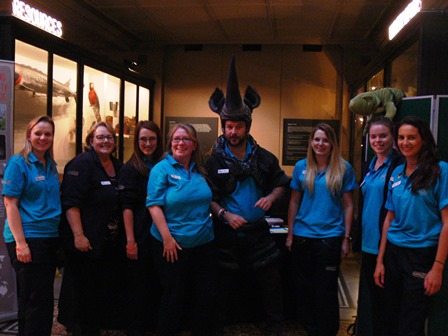
The event showcased the work researchers do in engaging ways, and promoted research careers to young people and their parents. To ensure vital conservation and science work continues into the future it’s important that we inspire and support the next generation.
It was the first time Manchester Museum hosted Science Uncovered Manchester and was a great evening showcasing local researchers and their work. There were hundreds of interactive activities taking place, all under one roof; promoting research careers to the next generation of scientists.
We thought it would be great to join a group of amazing and dynamic scientists in Manchester Museum for an after-hours takeover, showcasing all the various ways we work to protect wildlife in the UK and globally. Situated in the Living Worlds gallery (of course!) and equipped with toys, jars of zoo food, microchip detectors, video clips and ‘fake’ zoo poo!
We shared secrets revealed when our endocrinologists study the dung of our elephants and rhinos – clues to help breeding can be found in the poo! Our team also had a black rhino dating game that helped to explain the science behind conservation breeding for this rare but critically endangered species. Visitors also learnt about feeding fussy frogs from our nutritionist, discovered what we find from watching our animals with our behaviour and welfare scientist and about how we’re conserving native species around the zoo.
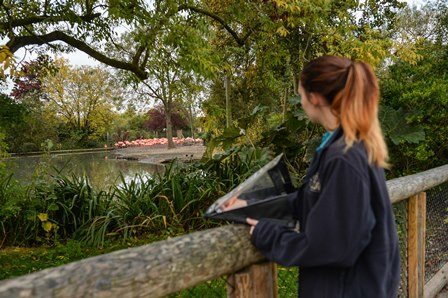
Everyone enjoyed revealing the science behind Chester Zoo’s conservation work with visitors and other scientists taking part in the event. If you missed it this time around, keep an eye out for details of next year’s event. If you can’t wait until then, our zoo nutritionist is taking part in Manchester Science Festival’s Girl Geek Dinner this evening.
Keep an eye on our blog for more updates from our science team or you can keep up to date with what they’re up to by following our science Twitter account. For more in-depth information you could take a look at our annual Science Reviews and publications.
Back in August, you may remember we asked for all budding artists to help us with a sculpture our artist in residence was creating to help us raise awareness of the impact palm oil is having on wildlife. This is just a part of our Palm Oil Challenge campaign.

 Visitors taking part in craft activities at Chester Zoo in August
Visitors taking part in craft activities at Chester Zoo in August
Thank you to all who took part. If you missed taking part in summer, we have another opportunity for you to get involved this October half term (Mon 26 – Fri 30, between 1-4pm): find out more here.
With your help, Angela Sidwell (the artist) aims to highlight the conservation issue and how the demand for this plant is impacting wildlife. Angela tells us a little more about how the creative workshops at the zoo went:
“I spent three days at Chester Zoo in my ‘mini studio’ developing ideas for sculptures I’m making for Chester Zoo – which will be exploring themes around the production of palm oil, loss of habitat and also the promotion of sustainable palm oil.

“It was a great opportunity to immerse myself in the project, work with zoo staff, meet visitors to talk about the project and of course be surrounded by the most amazing animals!
“I already had some ideas for the sculptures I intend to make for the project which I had drawn on paper. Being at the zoo enabled me to work through these ideas by making maquettes (small scale models) based on my drawings, whilst talking to staff and visitors, some of whom helped to create the models. We worked with clay and packaging taken from products that contain sustainable palm oil.
“The next stage is to work from these models to create large scale sculptures that will be on public display at the zoo for several months. These will be made predominantly with recycled packaging and fabrics and will feature Orangutans, an emerging palm oil plantation and a deforested area.”

Not only has Angela been working with Chester Zoo’s visitors to create this piece of artwork, she has visited a number of schools with our safari rangers.
Carrie Littlehales, one of our safari rangers, tells us more about the Palm Oil Art school visits, below:
“The first school visit for our palm oil art day was at St Theresa’s Catholic Primary School. I visited all the classes to help them create a palm leaf craft. Each student can take the leaf home, which has the Roundtable of Sustainable Palm Oil (RSPO) logo on it.
“Whilst I was going around the school, many of the students said ‘Hi Carrie!’ as I’d been to visit two weeks before, explaining what palm oil was and asking them to collect palm oil packaging for the sculpture that was being made at their school on this art day.
“Angela was getting a number of students from the school to help her make the sculpture. These students seemed to enjoy getting messy!
“Everyone loved their palm leaf – some made it into a fan, some a bracelet and even a hat! All were pleased they could take them home to show their families and tell them about palm oil. It’s been a great success!”
 Mini orangutan sculpture
Mini orangutan sculpture
We also have a couple of informal chats taking place at the zoo. These talks provide you with the chance to meet Chester Zoo staff members and learn more about our Palm Oil Challenge, how we’re leading the way for zoos with this campaign and the work we’re doing out in the field to protect orangutans. We look forward to seeing you there!
Talk one: Sustainable Palm Oil Challenge – meet the conservation officer (Mon 19th October, 2.30pm at Jaguar coffee house)
Talk two: Sustainable Palm Oil Challenge – meet the vets (Thu 22ndOctober, 2.30pm at Jaguar coffee house)
With over 200 of you getting ready to Go Orange for Orangutans this October, we’ve already heard some great fundraising stories from you.
We know many of you have been busy going orange or getting your great ape plans in place.
Thank you all for getting involved!
Oakwood Avenue Community Primary School was the very first school to Go Orange this year. Year One organised a Go Orange fair during their ‘Make a Difference’ week with wristbands and a bake sale, to raise a grand total of £346.05! This is enough to plant and nurture 34 new trees in the Bornean rainforest or keep a wildlife warden in action for over three weeks in Sumatra.
Here are Oakwood Avenue pupils looking suitably proud of their fantastic achievement:

After a successful sponsored silence, 8-year-old Olivia McCabe went on to do her first ever outdoor climb and abseil reaching 100ft to raise £377 for orangutans.

Here’s Olivia, along with Abigail Briggs and Dan Bentley who have each set themselves different challenges for the great orange ape, including the Leeds Primal Stampede and Chester Marathon!
However you choose to Go Orange for Orangutans, we’re here to help you all the way! We can’t wait to hear what you’ve got planned. Keep in touch by email: development@chesterzoo.org or social media via Twitter,Facebook or Instagram.
It’s not too late to join Go Orange for Orangutans – register now for your FREE fundraising pack and more!
Last year’s Go Orange for Orangutans campaign raised a magnificent £19,150 to plant 1,950 trees in Borneo by HUTAN, our partners working on the frontline of orangutan conservation.
Your support and donations really do help us to make a difference!
So, we asked Dr Marc Ancrenaz, co-director of HUTAN – Kinabatangan Orangutan Conservation Project (KOCP), to update us on how your support is helping orangutans in the wild.
“The KOCP Tree Planting Unit is working hard to rehabilitate several areas in the Lower Kinabatangan. The forest in these areas has been destroyed either by logging or for illegal palm oil development.
“The team chooses only areas where natural forest regeneration doesn’t happen, either because the soil is too compacted or because creepers entangle the young treelets and suffocates them.
 Trees planted in 2010 at one of the planting sites. This place was completely opened up all the way to the river illegally and was cutting off two patches of forest. Today a continuous corridor of trees, allow for safe dispersal by orangutans, proboscis monkeys and many other species, has been re-established. Photo credit: HUTAN
Trees planted in 2010 at one of the planting sites. This place was completely opened up all the way to the river illegally and was cutting off two patches of forest. Today a continuous corridor of trees, allow for safe dispersal by orangutans, proboscis monkeys and many other species, has been re-established. Photo credit: HUTAN
“Other threats jeopardize the survival of the seedlings: insects and caterpillars, rodents, wild boars or deer, etc. In order to ensure a better survival rate, the team monitors and maintains the plots every few weeks. This work is very demanding in terms of efforts and time, but it is necessary to achieve a survival rate that is more than 80% after three years of maintenance.
“After three years, we stop maintaining the sites where some of the treelets are already more than five meters high. At this stage the main threat is elephants; when they pull or push down some of our planted trees.
“The year 2015 has been very dry to date, with very little rain from February to May. Consequently nearly half of the young seedlings that were planted since the beginning of the year died already. The team is currently replacing these seedlings with new ones.
 A member of the planting team shows a young seedling planted in 2014 at the Avicess plot. We see the palms behind the trees that provide some shade and protection cover to the seedlings. Photo credit: HUTAN
A member of the planting team shows a young seedling planted in 2014 at the Avicess plot. We see the palms behind the trees that provide some shade and protection cover to the seedlings. Photo credit: HUTAN
“This year, some of the trees that were planted in the past by our team started to produce fruits: ficus tree, mallotus, payung payung, dillenia, etc. We have seen an afflux of trees, squirrels, monkeys and other fruit eater species during period of fructification in these plots. Orangutans started to roam in these plots as well, but no nests have been identified in our plot yet. Maybe next year…?
 The planting team on the way to the planting sites. Photo credit: HUTAN
The planting team on the way to the planting sites. Photo credit: HUTAN
“The funding allocated by Go Orange has been used to restore a 30 acre plot that had been illegally planted with oil palms in the past. So far nearly 10,000 seedlings from about 30 species have been planted here.
“The team monitors the growth and the survival rate of all these seedlings in order to determine what species grow better in this type of soil and tree cover conditions. We found out that removing the palms is not necessary for the seedlings to grow. In the contrary, mature palms provide some shade that benefit the seedlings and make them more resistant to dry periods.
 The team assessing the overall health of this seedling through a pre-established scoring system. Photo credit: HUTAN
The team assessing the overall health of this seedling through a pre-established scoring system. Photo credit: HUTAN
“The results are analyzed every year. This information is used to issue recommendations for forest restoration initiatives that are currently undertaken in Kinabatangan and in other areas that were encroached by the oil palm industry and other types of human activities.
 A young strangling fig tree that is growing out from a mature palm. Strangling figs are keystone species in Kinabatangan and their fruits sustain a wide diversity and abundance of species. Mature palms can offer efficient support that will allow these strangling figs to grow faster and better in the plots. Photo credit: HUTAN
A young strangling fig tree that is growing out from a mature palm. Strangling figs are keystone species in Kinabatangan and their fruits sustain a wide diversity and abundance of species. Mature palms can offer efficient support that will allow these strangling figs to grow faster and better in the plots. Photo credit: HUTAN
“The work of the Reforestation team is an eye opener for many about the value of the forest. Throughout the year, the team welcomes school children who can plant their own trees in order for them to become more aware about the importance of trees in our lives.
 A seedling planted this year – mature palms are visible in the back of the picture. Photo credit: HUTAN
A seedling planted this year – mature palms are visible in the back of the picture. Photo credit: HUTAN
“Last June, we also welcome two groups of students from the American-based Dragonfly programme. One of these students wrote the following:
“After speaking with many of the other Dragonfly students, it became clear that amongst all of the amazing experiences we had while traveling, many people felt most moved, motivated, and inspired by planting a tree in the rainforest. It seems this ‘simple’ act has permanently impacted their lives and really energized their desire to do more for orangutan conservation efforts. I myself even wrote about working with the Reforestation Unit as the most impactful moment of my trip and I still smile when I think about the trees I planted being watched over by such a dedicated group of women in hopes that they will someday support orangutans and much of the other amazing biodiversity in the area.”
This really captures what the KOCP Reforestation team is trying to achieve through their hard work: inspiring people to care more about trees and their environment!
Let’s beat last year’s fundraising efforts and reach £50,000 for orangutan conservation! It’s time to Go Orange for Orangutans!